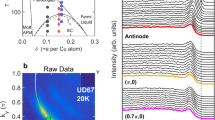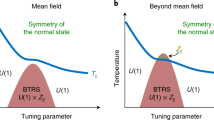Abstract
Although the binding of electrons into Cooper pairs is essential in forming the superconducting state, its remarkable properties—zero resistance and perfect diamagnetism—require phase coherence among the pairs as well. When coherence is lost at the transition temperature T c, pairing remains, together with phase correlations which are finite in space and time. In conventional metals, Cooper pairs with short-range phase coherence survive no more than 1 K above T c. In underdoped high-T c copper oxides, spectroscopic evidence for some form of pairing is found up to a temperature T *, which is roughly 100 K above T c (refs 1,2,3). How this pairing and Cooper-pair formation are related is a central problem in high-T c superconductivity. The nature of this relationship hinges on the extent to which phase correlations accompany pairing in the normal state4. Here we report measurements of high-frequency conductivity that track the phase-correlation timeτ in the normal state of the Bi2Sr2CaCu2O8+δ family of underdoped copper oxide superconductors. Just above T c, we find that τ reflects the motion of thermally generated topological defects in the phase, or vortices5,6. However, vortex proliferation reduces τ to a value indistinguishable from the lifetime of normal-state electrons at 100 K, well below T *.
This is a preview of subscription content, access via your institution
Access options
Subscribe to this journal
Receive 51 print issues and online access
$199.00 per year
only $3.90 per issue
Buy this article
- Purchase on Springer Link
- Instant access to full article PDF
Prices may be subject to local taxes which are calculated during checkout




Similar content being viewed by others
References
Loesser, A. G. et al. Excitation gap in the normal state of Bi2Sr2CaCu2O8+δ. Science 273, 325–329 (1996).
Ding, H. et al. Spectroscopic evidence for a pseudogap in the normal state of underdoped high-T csuperconductors. Nature 382, 51–54 (1996).
Renner, Ch. et al. Pseudogap precursor of the superconducting gap in under- and overdoped Bi2Sr2CaCu2O8+δ. Phys. Rev. Lett. 80, 149–152 (1998).
Emery, V. J. & Kivelson, S. A. Importance of phase fluctuations in superconductors with small superfluid density. Nature 374, 434–437 (1995).
Berezinskii, V. L. Destruction of long-range order in one-dimensional and two-dimensional systems having a continuous symmetry group I. Classical systems. Sov. Phys. JETP 32, 493–500 (1970); II. Quantum systems. Sov. Phys. JETP 34, 610–617 (1972).
Kosterlitz, J. M. & Thouless, D. J. Ordering, metastability and phase transitions in two-dimensional systems. J. Phys. C 6, 1181–1203 (1973).
Harris, J. M. et al. Anomalous superconducting state gap size versus Tcbehavior in underdoped Bi2Sr2Ca1−xDyxCu2O8+δ. Phys. Rev. B 54, 15665–15668 (1996).
Doniach, S. & Inui, M. Long-range Coulomb interactions and the onset of superconductivity in the high-Tcmaterials. Phys. Rev. B 41, 6668–6678 (1990).
Nuss, M. C. & Orenstein, J. in Millimeter and Submillimeter Spectroscopy of Solids (ed. Grüner, G.) 7–50 (Topics in Applied Physics Vol. 74, Springer, New York, (1998).
Eckstein, J. N. & Bozovic, I. High-temperature superconducting multilayers and heterostructures grown by atomic layer-by-layer molecular beam epitaxy. Annu. Rev. Mater. Sci. 25, 679–709 (1995).
Kosterlitz, J. M. & Nelson, D. R. Universal jump in the superfluid density of two-dimensional superfluids. Phys. Rev. Lett. 39, 1201–1205 (1977).
Ambegaokar, V., Halperin, B. I., Nelson, D. R. & Siggia, E. D. Dynamics of superfluid films. Phys. Rev. B 20, 1806–1826 (1980).
Halperin, B. I. & Nelson, D. R. Resistive transition in superconducting films. J. Low Temp. Phys. 36, 599–616 (1979).
Minnhagen, P. The two-dimensional Coulomb gas, vortex unbinding, and superfluid-superconducting films. Rev. Mod. Phys. 59, 1001–1066 (1987).
Jonsson, A. & Minnhagen, P. Characteristics of two-dimensional vortex dynamics from XY -type models with Ginzburg-Landau dynamics. Phys. Rev. B 55, 9035–9046 (1997).
Bardeen, J. & Stephen, M. J. Theory of the motion of vortices in superconductors. Phys. Rev. A 140, 1197–1207 (1965).
Lee, P. A. & Wen, X. G. Unusual superconducting state of underdoped cuprates. Phys. Rev. Lett. 78, 4111–4114 (1997).
Acknowledgements
This work was supported by the NSF, DOE and ONR. J.O. thanks the Aspen Center for Physics for the opportunity to discuss this work with participants of its high-T c workshop.
Author information
Authors and Affiliations
Corresponding author
Rights and permissions
About this article
Cite this article
Corson, J., Mallozzi, R., Orenstein, J. et al. Vanishing of phase coherence in underdoped Bi2Sr2CaCu2O8+δ. Nature 398, 221–223 (1999). https://doi.org/10.1038/18402
Received:
Accepted:
Issue Date:
DOI: https://doi.org/10.1038/18402
This article is cited by
-
Evidence for d-wave superconductivity of infinite-layer nickelates from low-energy electrodynamics
Nature Materials (2024)
-
Absence of a BCS-BEC crossover in the cuprate superconductors
npj Quantum Materials (2023)
-
The emergence of global phase coherence from local pairing in underdoped cuprates
Nature Physics (2023)
-
Scattering interference signature of a pair density wave state in the cuprate pseudogap phase
Nature Communications (2021)
-
Non-linear Terahertz driving of plasma waves in layered cuprates
Nature Communications (2021)
Comments
By submitting a comment you agree to abide by our Terms and Community Guidelines. If you find something abusive or that does not comply with our terms or guidelines please flag it as inappropriate.



